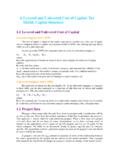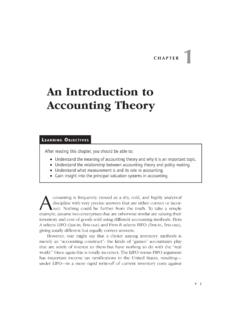Transcription of Ratio Analysis and Equity Valuation: From Research to …
1 Review of Accounting Studies, 6, 109 154, 2001 C2001 Kluwer Academic Publishers. Manufactured in The Analysis and Equity Valuation: From Research to PracticeDORON University, Graduate School of Business, 3022 Broadway, Uris Hall 604, New York, NY 10027 STEPHEN H. University, Graduate School of Business, 3022 Broadway, Uris Hall 612, New York, NY statement Analysis has traditionally been seen as part of the fundamental Analysis requiredfor Equity valuation . But the Analysis has typically been ad hoc. Drawing on recent Research on accounting-basedvaluation, this paper outlines a financial statement Analysis for use in Equity valuation . Standard profitabilityanalysis is incorporated, and extended, and is complemented with an Analysis of growth.
2 An Analysis of operatingactivities is distinguished from the Analysis of financing activities. The perspective is one of forecasting payoffsto equities. So financial statement Analysis is presented as a matter of pro forma Analysis of the future, withforecasted ratios viewed as building blocks of forecasts of payoffs. The Analysis of current financial statements isthen seen as a matter of identifying current ratios as predictors of the future ratios that determine Equity financial statement Analysis is hierarchical, with ratios lower in the ordering identified as finer informationabout those higher up. To provide historical benchmarks for forecasting, typical values for ratios are documentedfor the period 1963 1999, along with their cross-sectional variation and correlation.
3 And, again with a view toforecasting, the time series behavior of many of the ratios is also described and their typical long-run, steady-state levels are :Financial statement Analysis , Ratio Analysis , Equity valuationIt goes almost without saying that, in an applied discipline like accounting, the aim ofresearch is to affect practice. Theory can be admired on a number of dimensions, but a streamof Research is ultimately judged on the products it delivers, how it enhances and medical Research , to name just two endeavors, have this orientation. Ourcolleagues in finance have been successful in product development. While making majorcontributions to economic theory, they have also engineered such products as derivativepricing, risk measurement, hedging instruments, portfolio insurance, and asset allocation,some, to be sure, more successful than the area of Equity Analysis , Research in finance has not been successful.
4 Equity Analysis or fundamental Analysis was once the mainstream of finance. But, while enormous stepshave been taken in pricing derivatives on the Equity , techniques to value equities have notadvanced much beyond applying the dividend discount model. So-called asset pricing mod-els, like the Capital Asset Pricing Model, have been developed, but these are models of riskand the expected return, not models that instruct how to value equities. Real option anal-ysis has been applied to Equity valuation , but the measurement problems are progress has been made by accounting researchers in what has come to be referredto as accounting-based valuation Research . That is not surprising. Equity Analysis is largelyan Analysis of information, and accountants deal with information about firms.
5 This papercarries the recent Research to the level of product AND PENMANT raditional fundamental Analysis (before modernfinance) was very much grounded in thefinancial statements. So, for example, Graham, Dodd and Cottle sSecurity Analysis (1962)is not the security Analysis of modernfinance texts (that involves the Analysis of prices, betaestimation, and asset allocation), but rather security Analysis that analyzes fundamentalsthrough thefinancial statements. However,financial statement measures were linked toequity value in an ad hoc way, so little guidance was given for understanding the implicationsof a particular Ratio a profit margin or an inventory turnover, for example for Equity was a comprehensive scheme advanced for identifying, analyzing and summarizing financial statement information in order to draw a conclusion as to what the statements, asa whole, say about Equity value.
6 Equity value is determined by future earnings power, it was said, but there was no explicit justification for using future earnings as a valuationattribute, nor was there explicit development of the forecasting of this earnings considerable amount of accounting Research in the years since Graham, Dodd andCottle has been involved in discovering howfinancial statements inform about Equity whole endeavor of capital markets Research deals with the information content offinancial statements for determining stock prices. The extensive time-series-of-earnings literature summarized in Brown (1993) focuses on forecasting earnings, often with valuationin mind. Papers such as Lipe (1986), Ou (1990), Ou and Penman (1989), Lev and Thiagarajan(1993) and Fairfield, Sweeney and Yohn (1996), to name just a few, have examined the roleof particularfinancial statement components and ratios in forecasting.
7 But it is fair to saythat the Research has been conducted without much structure. Nor has it produced manyinnovations for practice. Interesting, robust empirical correlations have been documented,but the Research has not produced a convincingfinancial statement Analysis for equityvaluation. Indeed the standard textbook schemes for analyzing statements, such as theDuPont scheme, rarely appear in the on recent Research on accounting-based valuation , this paper ventures to producea structural approach tofinancial statement Analysis for Equity valuation . The structure notonly identifies relevant ratios , but also provides a way of organizing the Analysis task. Theresult is a fundamental Analysis that is very much grounded in thefinancial statements;indeed, fundamental Analysis is cast as a matter of appropriatefinancial statement structural approach contrasts to the purely empirical approach in Ou and Penman(1989).
8 That paper identified ratios that predicted earnings changes in the data; no thoughtwas given to the identification. The approach also contrasts to that in Lev and Thiagarajan(1993) who defer to expert judgment and identify ratios that analysts actually use involves forecasting payoffs. Forecasting is guided by an Equity valuation modelthat specifies what is to be forecasted. So, for example, the dividend discount model directsthe analyst to forecast dividends. Because it focuses on accrual-accountingfinancial state-ments, the residual income valuation model, recently revived through the work of Ohlson(1995) and Feltham and Ohlson (1995), serves as an analytical device to organize thinkingabout forecasting and analyzingfinancial statements for forecasting.
9 This model is a state-ment of how book value and forecasted earnings relate to forecasted dividends and thusto value. The Ratio Analysis in this paper follows from recognition of standard accountingrelations that determine how components of thefinancial statements relate to earnings andbook Analysis AND Equity VALUATION111 Our focus on the residual income valuation model is not to suggest that this model is theonly model, or even the best model, to value equities. Penman (1997) shows that dividendand cash-flow approaches give the same valuation as the residual income approach undercertain conditions. The residual income model, based as it is on accrual accounting, isof particular help in developing an Analysis of accrual-accountingfinancial cashflows and dividends are tied to accrual numbers by straightforward accountingrelations, so building forecasts of accrual accounting numbers with the aid of Analysis buildsforecasts of free cashflows and dividends also, as will be scheme is not offered as the definitive way of going aboutfinancial statement is some judgment as to what makes sense.
10 This is inevitably part of the art of designin bringing academic models to practice (Colander (1992)). As such it stands as a point ofdeparture for those with better paper comes in two parts. First it identifies ratios that are useful for valuation . Second,it documents typical values of the ratios during the period 1963 to earnings valuation techniques are so-called because Equity valueis determined by forecasting residual income. As a matter offirst order, Ratio identificationamounts to identifying ratios that determine or drive future residual income so that, byforecasting these ratios , the analyst builds a forecast of residual income. So relevant ratiosare identified as the building blocks of a forecast, that is, as the attributes to be forecastedin order to build up a forecast of residual income.













